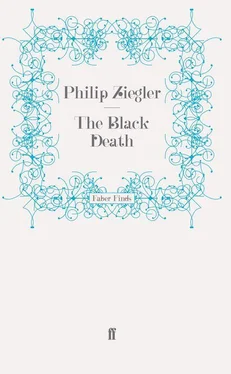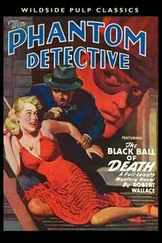The sufferings of local populations and how they lived with pestilence are studied by Richard Gyug, ‘The effects and extent of the Black Death of 1348: new evidence for clerical mortality in Barcelona’, Medieval Studies, 45 (1983), pp. 385–98, Richard Lomas, ‘The Black Death in County Durham’, Journal of Medieval History, 15 (1989), pp. 127–40, R. A. Davies, ‘The effect of the Black Death on the parish priests of the medieval diocese of Coventry and Lichfield’, Historical Research, 62 (1989), pp. 85–90, Ray Lock, ‘The Black Death in Walsham-le-Willows’, Proceedings of the Suffolk Institute of Archaeology and History, 37 (1992), pp. 316–37, Daniel Lord Smail, ‘Accommodating plague in medieval Marseille’, Continuity and Change, 11 (1996), pp. 11–41, and William J. Dohar, The Black Death and Pastoral Leadership. The diocese of Hereford in the fourteenth century (Philadelphia, 1995). As for the medical profession, its first response to the plague is the subject of John Henderson’s ‘Epidemics in Renaissance Florence: medical theory and government response’ in Maladies etsociété (xii e – xvii esiècles), eds. N. Bulst and R. Delort (Paris, 1989), pp. 165–86, and of the same author’s ‘The Black Death in Florence: medical and communal responses’, in Death in Towns. Urban responses to the dying and the dead, 100–1600, ed. Steven Bassett (Leicester, 1992), pp. 136–50. John Henderson’s major book on Piety and Charity in Late Medieval Florence (Oxford, 1994) includes a chapter on ‘Charity, the Poor, and the Aftermath of the Black Death, 1348–1400’ (pp. 297–353). For other Tuscan studies, see David Herlihy’s ‘Deaths, marriages, births, and the Tuscan economy ( c. 1300–1550)’, in Population Patterns in the Past, ed. Ronald Demos Lee (New York, 1977), pp. 135–64, and the two books by Samuel K. Cohn on Death and Property in Siena, 1205–1800. Strategies for the afterlife (Baltimore, 1988) and on The Cultof Remembrance and the Black Death. Six Renaissance cities in Central Italy (Baltimore, 1992).
Large claims are now being made for the Black Death’s primacy in world affairs, as in William H. McNeill’s Plagues and People (Oxford, 1977) and William M. Bowsky’s valuable compendium, The Black Death. A turning point in history? (New York, 1971). Richard C. Palmer makes a similar claim for English Law in the Age of the Black Death, 1348–1381 (Chapel Hill and London, 1993), whereas Mark Ormrod in ‘The English government and the Black Death of 1349–79’, in England in the Fourteenth Century, ed. W. M. Ormrod (Woodbridge, 1986), pp. 175–88, is keener to stress how little changed. That older view of institutional continuity still has much to recommend it. And a useful counter to Palmer’s book is Edward Powell’s more temperate Kingship, Law, and Society. Criminal justice in the reign of Henry V (Oxford, 1989). However, in social history generally, Samuel K. Cohn’s recent edition of the late David Herlihy’s unpublished essays on The Black Death and the Transformation of the West (Cambridge Mass., 1997) is a good demonstration of how far Black Death studies have moved on. For even Herlihy, the doyen of late-medieval urban demography, had become convinced that there was insufficient evidence of a population down-turn before the Black Death to justify the belief of many historians of his own generation – influencing Philip Zieger among others – that plague was less the cause than an accelerator of social change.
Those changes had been the subject of a long-running debate in the journal Past & Present, which generated such interest that it was re-issued in book form as The Brenner Debate. Agrarian Class structure and economic development in pre-industrial Europe, eds. T. H. Aston and C. H. E. Philpin (Cambridge, 1985). The debate has since been continued in S. R. Epstein’s ‘Cities, regions, and the late medieval crisis: Sicily and Tuscany compared’, Past & Present , 130 (1991). pp. 3–50. And one of its concerns has always been to establish the chronology of the crisis. Guy Bois, author of The Crisis of Feudalism. Economy and society in Eastern Normandy c. 1300–1550 (Paris, 1976; Cambridge, 1984) and a contributor to the original debate, had taken the view that it was the Great Famine of 1315–17 which was the turning-point. And following Ian Kershaw’s examination of that crisis in ‘The Great Famine and agrarian crisis in England 1315–22’, Past & Presently , 59 (1973), pp. 3–50, a levelling-off of Europe’s population in (or before) those years had seemed established. Yet the setback, it now appears, was only temporary. In Before the Black Death, Studies in the ‘crisis’ of the early fourteenth century, ed. Bruce M. S. Campbell (Manchester, 1991), Barbara Harvey’s answer to the question ‘Was there actually a crisis?’ was unequivocal. The reverses of the half-century before the Black Death were not a turning-point, she concluded firmly, but ‘a mid-term crisis’. In reality, it was ‘the advent of plague, an exogenous factor, that transformed the economic life of Western Europe in the later Middle Ages, and the changes which actually occurred after that event could not have predicted in the first half of the century’ (p. 24).
It had been Bruce Campbell’s fine study of the peasant land market in Coltishall (‘Population pressure, inheritance and the land market in a fourteenth-century peasant community’, in Land, Kinship and Life-Cycle, ed. R. M. Smith [Cambridge, 1984], pp. 87–134) that had caused David Herlihy to change his mind. Campbell was clear that the crisis in Norfolk’s Coltishall was the result ‘not of economic but of biological factors’. And much of the recent work on the socio-economic history of late-medieval England has served to reinforce that conclusion. For summaries of that work, see The Black Death in England, eds. Mark Ormrod and Phillip Lindley (Stamford, 1996), and my own King Death, The Black Death and its aftermath in late-medieval England (London, 1996). In the specialist literature, Campbell and Bailey, Bridbury and Britnell, Dyer and Goldberg, Harvey and Hatcher, Mate, Pollard, Poos and Razi are the names to watch. Of these, A. R. Bridbury has always taken the view that there was less crisis than opportunity in post-plague England, his position hardly changing from the publication of his iconoclastic Economic Growth, England in the later Middle Ages (London 1962) – cited in Ziegler’s bibliography – through ‘The Black Death’, Economic History Review, 26 (1973), pp.577–92, to the collected papers of Bridbury’s The English Economy from Bede to the Reformation (Woodbridge, 1992). Most historians, however, now see it differently. And there is growing agreement that it was the Black Death – more than famine, climatic deterioration, bullion shortages, or any other single cause – that first prepared the way for the ‘long’ fifteenth century of economic recession and social change.
How the Recession ended is the subject of The Closing of the Middle Ages’ England, 1471–1529 (Oxford, 1997) by Richard Britnell, who has written usefully also on the earlier period in Growth and Decline in Colchester, 1300–1525 (Cambridge, 1986), in The Commercialisation of English Society 1000–1500 (Cambridge, 1993), and in ‘The Black Death in English towns’, Urban History, 21 (1994), pp. 195–210. And there are summaries of the views of Campbell and Dyer, the two most prolific authors on this period, in Bruce Campbell’s ‘A fair field once full of folk: agrarian change in an ere of population decline, 1348–1500’, Agricultural History Review, 41 (1993), pp. 60–70, and Christopher Dyer’s Standards of Living in the Later Middle Ages. Social change in England c. 1200–1520 (Cambridge, 1989). Valuable regional studies, each of much wider application, include Mark Bailey’s A Marginal Economy? East Anglian Breckland in the later Middle Ages (Cambridge, 1989); P. J. P. Goldberg’s ‘Mortality and economic change in the diocese of York, 1390–1514’, Northern History, 14 (1988), pp. 38–55, and his Women, Work, and Life Cycle in a Medieval Economy. Women in York and Yorkshire c. 1300–1520 (Oxford, 1992); Mavis Mate’s ‘Agrarian economy after the Black Death: the manors of Canterbury Cathedral Priory, 1348–91’, Economic History Review, 37 (1984), pp. 341–54, and her ‘Labour and labour services on the estates of Canterbury Cathedral Priory in the fourteenth century’, Southern History, 7 (1985), pp. 55–67; A. J. Pollard’s ‘The north-eastern economy and the agrarian crisis of 1438–1440’, Northern History, 25 (1989), pp. 88–105; L. R. Poos’s ‘The rural population of Essex in the later Middle Ages’, Economic History Review, 38 (1985), pp. 515–30, and his A Rural Society after the Black Death: Essex 1350–1525 (Cambridge, 1991); and the many West Midlands studies of Zvi Razi, beginning with Life, Marriage and Death in a medieval parish. Economy, society and demography in Halesowen 1270–1400 (Cambridge, 1980), and including his two important papers. ‘Family, land and the village community in later medieval England’. Past & Present , 93 (1981), pp. 3–36. and ‘The myth of the immutable English family’, ibid. , 140 (1993), pp. 3–44.
Читать дальше












